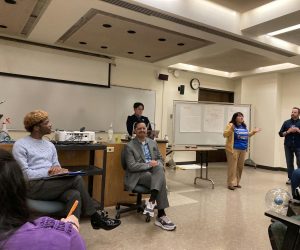“Swarm” Worth the Buzz?
A Review of the Killer New Amazon Prime Series
April 21, 2023
The new Amazon Prime series “Swarm” initially stirred up a lot of buzz around its portrayal of a certain “Queen Bee” of pop: *cough cough – Beyoncé*.
Beyoncé, like many other pop artists, is known for having an extremely dedicated fanbase called “the hive”, who sometimes take being a fan to an extreme. What happens though when this fandom takes it to too far of an extreme, and it becomes obsessive or even dangerous? This question is central to the plot as well as themes that the show “Swarm” beckons its audience to explore.
“Swarm” is a horror/comedy/thriller limited series that follows Dre, a hardcore fan of an uber-famous pop star named Ni’Jah. Dre is triggered by a life-altering event that spirals her into going on a killing spree as a means to defend Ni’Jah from haters, as well as killing anyone who stands in Dre’s way of getting as close to her idol as possible.
Beyoncé is never explicitly mentioned in the show, but it is abundantly clear through the story and visuals that Ni’Jah is meant to emulate the real-life popstar. Each episode even begins with a witty disclaimer that reads, “This is not a work of fiction. Any similarity to actual persons, living or dead, or actual events, is intentional”.
While “Swarm” is largely a fictional story, like the character of Dre and her murder spree, some situations are based on real events. This was confirmed by one of the main writers/co-creators of the show, Janine Nabers, in a Variety Magazine article. The little disclaimer is also a cheeky way for the writers to affirm their intention of referencing Beyoncé throughout the series.
There are seven episodes total, with each taking us along Dre’s journey as a serial killer with new sets of victims throughout a few years of her spree. Episode six is the only one that bluntly strays from this structure.
Episode six is a meta-episode that takes us outside of the story for a moment. It is filmed as a faux-documentary following a Detective Loretta Greene as she investigates a string of murders she believes to be connected. She eventually pieces them together and uncovers Dre as the main suspect.
This episode gives the viewer a chance to learn vital background information on Dre to have a better understanding of her character. More importantly, though, this episode is also thoughtfully utilized as a clever way of opening up discussion of themes that drove the creators to make this show in the first place.
Co-creator Nabers goes into great detail overviewing her inspirations for the show as well as thematic points she sought to make in a recent Vulture interview. She describes an initial spark of inspo co-creator Donald Glover had when he first pitched the show. He came across a Tweet from a teacher he follows, a black woman, that read, “I’m so tired of seeing Black women on TV play therapists and lawyers and doctors and people who just have their sh*t together. We can be serial killers too”.
Especially within American pop-culture, there is a deep fascination with white-male serial killers, as evidenced through the countless film and series adaptations of them and their stories. But we almost never see black, let alone black-female ones, why is that?
Nabers discussed Dre’s character of being representative of the many black women, even serial killers, that have fallen through the cracks of society. “…[Dre’s] been a little bit of a fly on the wall in her own life…but she’s fallen through the cracks…No one’s able to really give her body of work the analysis that it deserves—like, why she did this and what led her to this—in the way that you look at Ted Bundy. I mean, his Wikipedia page is crazy. There’s just so much. So many people have studied him. So how can we study this character [of Dre]?”
Nabers has emphasized that the series aims to spark conversations, dialogues and discussions that perhaps we as a society are afraid to have. With humility, she expressed, “I really want this show to start a movement for Black writers to feel unafraid to tackle any subject matter and tell it in as punk a way as possible. I remember watching Shonda Rhimes shows and being like, D*mn, that woman is Black and she’s doing that. And now there are Black people telling a story I never thought I would see Black people tell. That’s the thing: We want a conversation.”
Overall, I appreciate the series’ portrayal of the driving forces and themes of uplifting Black voices and storytelling. It is crucial to see this happening more, and I hope it continues throughout Hollywood and society as a whole.
Moreover, the series is quite visually enthralling. Its use of color, lighting, editing and overall cinematography create a surrealistic feel that perfectly complements the satirical and dark mood of the show.
Dominique Fishback’s depiction of Dre, a strange, quiet-at-times, chaotic and murderous character, deserves high applause. Although Dre’s character is often verbally inept, Fishback evokes her emotions with expertly acted mannerisms. Even through her eyes and eye movements, viewers are able to interpret exactly what Dre is thinking and feeling. Fishback’s acting brings out a certain complexity to Dre’s character that forces the audience to question their relationship and analysis of her.
Regarding the show’s story as a whole, towards the end, I found myself getting a little bored. The first few episodes hooked me in instantly, but watching Dre just going around killing people became repetitive after a while. I felt myself craving a little more complexity plot-wise, but even with this said, the series was still entertaining overall.
I finished watching the series within two to three days. For an experienced binge-watcher, I could see someone even being able to get through it in a day. So if you are searching for a dark, thought-provoking, quick-watch, then this series is definitely worth the buzz.







